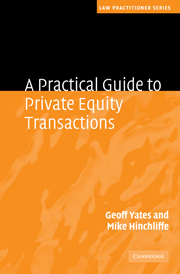Book contents
- Frontmatter
- Contents
- List of figures
- Foreword
- Preface and acknowledgments
- Table of cases
- 1 An introduction to private equity
- 2 The deal process and preliminary matters
- 3 Transaction structures and deal documents
- 4 Acquisition issues
- 5 Equity documentation
- 6 Debt funding
- 7 Employment-related issues
- 8 Pensions
- 9 Tax on private equity transactions
- 10 Public-to-private transactions
- 11 Living with the investment
- 12 Secondary buyouts
- 13 Exits
- Index
3 - Transaction structures and deal documents
Published online by Cambridge University Press: 04 May 2010
- Frontmatter
- Contents
- List of figures
- Foreword
- Preface and acknowledgments
- Table of cases
- 1 An introduction to private equity
- 2 The deal process and preliminary matters
- 3 Transaction structures and deal documents
- 4 Acquisition issues
- 5 Equity documentation
- 6 Debt funding
- 7 Employment-related issues
- 8 Pensions
- 9 Tax on private equity transactions
- 10 Public-to-private transactions
- 11 Living with the investment
- 12 Secondary buyouts
- 13 Exits
- Index
Summary
Introduction
In this chapter, we will look at some typical structures for transactions featuring private equity funding in the UK. This has become an increasingly complex area in recent years for a number of reasons. As private equity investors have looked to acquire larger target companies, and utilised leverage as much as possible in doing so (as we saw in chapter 1), so structures have become more complex to accommodate that debt. A growing number of transactions involve the acquisition of a target with substantial operations outside the UK, which may necessitate a more complicated deal structure. Tax matters dominate, however, as rules governing the taxation of returns payable to both managers and investors must be borne in mind, in addition to any specific tax issues in respect of the target group.
These issues now have such a far-reaching impact that even a relatively low-value and simple private equity deal may nevertheless involve a complex structure. As a result, it can be difficult for anyone embarking on a private equity transaction for the first time to appreciate the fundamental commercial dynamics of a deal, and how a particular deal structure accommodates them. For that reason, this chapter will begin by examining the key players in a simple transaction, and the most straightforward deal structure that might emerge in that situation, which helps to demonstrate how private equity investors look to achieve the returns referred to in chapter 1.
- Type
- Chapter
- Information
- A Practical Guide to Private Equity Transactions , pp. 47 - 68Publisher: Cambridge University PressPrint publication year: 2010



